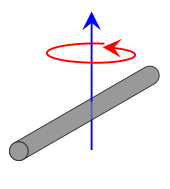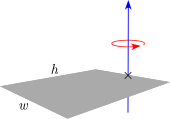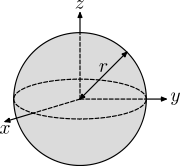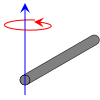| Description |
Figure |
Moment(s) of inertia
|
| Point mass M at a distance r from the axis of rotation.
A point mass does not have a moment of inertia around its own axis, but using the parallel axis theorem a moment of inertia around a distant axis of rotation is achieved.
|

|
I
=
M
r
2
{displaystyle I=Mr^{2}}

|
| Two point masses, m1 and m2, with reduced mass μ and separated by a distance x, about an axis passing through the center of mass of the system and perpendicular to the line joining the two particles.
|

|
I
=
m
1
m
2
m
1
+
m
2
x
2
=
μ
x
2
{displaystyle I={frac {m_{1}m_{2}}{m_{1}!+!m_{2}}}x^{2}=mu x^{2}}

|
| Thin rod of length L and mass m, perpendicular to the axis of rotation, rotating about its center.
This expression assumes that the rod is an infinitely thin (but rigid) wire. This is a special case of the thin rectangular plate with axis of rotation at the center of the plate, with w = L and h = 0.
|

|
I
c
e
n
t
e
r
=
1
12
m
L
2
{displaystyle I_{mathrm {center} }={frac {1}{12}}mL^{2},!}

|
| Thin rod of length L and mass m, perpendicular to the axis of rotation, rotating about one end.
This expression assumes that the rod is an infinitely thin (but rigid) wire. This is also a special case of the thin rectangular plate with axis of rotation at the end of the plate, with h = L and w = 0.
|

|
I
e
n
d
=
1
3
m
L
2
{displaystyle I_{mathrm {end} }={frac {1}{3}}mL^{2},!}

|
| Thin circular loop of radius r and mass m.
This is a special case of a torus for a = 0 (see below), as well as of a thick-walled cylindrical tube with open ends, with r1 = r2 and h = 0.
|

|
I
z
=
m
r
2
{displaystyle I_{z}=mr^{2}!}

I
x
=
I
y
=
1
2
m
r
2
{displaystyle I_{x}=I_{y}={frac {1}{2}}mr^{2},!}

|
| Thin, solid disk of radius r and mass m.
This is a special case of the solid cylinder, with h = 0. That
I
x
=
I
y
=
I
z
2
{displaystyle I_{x}=I_{y}={frac {I_{z}}{2}},}
 is a consequence of the perpendicular axis theorem. is a consequence of the perpendicular axis theorem.
|

|
I
z
=
1
2
m
r
2
{displaystyle I_{z}={frac {1}{2}}mr^{2},!}

I
x
=
I
y
=
1
4
m
r
2
{displaystyle I_{x}=I_{y}={frac {1}{4}}mr^{2},!}

|
| A uniform annulus (disk with a concentric hole) of mass m, inner radius r1 and outer radius r2
|

|
I
z
=
1
2
m
(
r
1
2
+
r
2
2
)
{displaystyle I_{z}={frac {1}{2}}m(r_{1}^{2}+r_{2}^{2})}

I
x
=
I
y
=
1
4
m
(
r
1
2
+
r
2
2
)
{displaystyle I_{x}=I_{y}={frac {1}{4}}m(r_{1}^{2}+r_{2}^{2})}

|
An annulus with a constant area density
ρ
A
{displaystyle rho _{A}}

|
I
z
=
1
2
π
ρ
A
(
r
2
4
−
r
1
4
)
{displaystyle I_{z}={frac {1}{2}}pi rho _{A}(r_{2}^{4}-r_{1}^{4})}

I
x
=
I
y
=
1
4
π
ρ
A
(
r
2
4
−
r
1
4
)
{displaystyle I_{x}=I_{y}={frac {1}{4}}pi rho _{A}(r_{2}^{4}-r_{1}^{4})}

|
| Thin cylindrical shell with open ends, of radius r and mass m.
This expression assumes that the shell thickness is negligible. It is a special case of the thick-walled cylindrical tube for r1 = r2.
Also, a point mass m at the end of a rod of length r has this same moment of inertia and the value r is called the radius of gyration.
|

|
I
≈
m
r
2
{displaystyle Iapprox mr^{2},!}

|
| Solid cylinder of radius r, height h and mass m.
This is a special case of the thick-walled cylindrical tube, with r1 = 0.
|

|
I
z
=
1
2
m
r
2
{displaystyle I_{z}={frac {1}{2}}mr^{2},!}

I
x
=
I
y
=
1
12
m
(
3
r
2
+
h
2
)
{displaystyle I_{x}=I_{y}={frac {1}{12}}mleft(3r^{2}+h^{2}right)}

|
| Thick-walled cylindrical tube with open ends, of inner radius r1, outer radius r2, length h and mass m.
|

|
I
z
=
1
2
m
(
r
2
2
+
r
1
2
)
=
m
r
2
2
(
1
−
t
+
t
2
2
)
{displaystyle I_{z}={frac {1}{2}}mleft(r_{2}^{2}+r_{1}^{2}right)=mr_{2}^{2}left(1-t+{frac {t^{2}}{2}}right)}

where t = (r2 − r1)/r2 is a normalized thickness ratio;
I
x
=
I
y
=
1
12
m
(
3
(
r
2
2
+
r
1
2
)
+
h
2
)
{displaystyle I_{x}=I_{y}={frac {1}{12}}mleft(3left(r_{2}^{2}+r_{1}^{2}right)+h^{2}right)}

The above formula is for the xy plane passing through the center of mass, which coincides with the geometric center of the cylinder. If the xy plane is at the base of the cylinder, i.e. offset by
d
=
h
2
,
{displaystyle d={frac {h}{2}},}
 then by the parallel axis theorem the following formula applies: then by the parallel axis theorem the following formula applies:
I
x
=
I
y
=
1
12
m
(
3
(
r
2
2
+
r
1
2
)
+
4
h
2
)
{displaystyle I_{x}=I_{y}={frac {1}{12}}mleft(3left(r_{2}^{2}+r_{1}^{2}right)+4h^{2}right)}

|
| With a density of ρ and the same geometry
|
I
z
=
π
ρ
h
2
(
r
2
4
−
r
1
4
)
{displaystyle I_{z}={frac {pi rho h}{2}}left(r_{2}^{4}-r_{1}^{4}right)}

I
x
=
I
y
=
π
ρ
h
12
(
3
(
r
2
4
−
r
1
4
)
+
h
2
(
r
2
2
−
r
1
2
)
)
{displaystyle I_{x}=I_{y}={frac {pi rho h}{12}}left(3(r_{2}^{4}-r_{1}^{4})+h^{2}(r_{2}^{2}-r_{1}^{2})right)}

|
| Regular tetrahedron of side s and mass m with an axis of rotation passing through a tetrahedron's vertex and its center of mass
|

|
I
s
o
l
i
d
=
1
20
m
s
2
{displaystyle I_{mathrm {solid} }={frac {1}{20}}ms^{2},!}

I
h
o
l
l
o
w
=
1
12
m
s
2
{displaystyle I_{mathrm {hollow} }={frac {1}{12}}ms^{2},!}

|
| Regular octahedron of side s and mass m
|

|
I
x
,
h
o
l
l
o
w
=
I
y
,
h
o
l
l
o
w
=
I
z
,
h
o
l
l
o
w
=
1
6
m
s
2
{displaystyle I_{x,mathrm {hollow} }=I_{y,mathrm {hollow} }=I_{z,mathrm {hollow} }={frac {1}{6}}ms^{2},!}

I
x
,
s
o
l
i
d
=
I
y
,
s
o
l
i
d
=
I
z
,
s
o
l
i
d
=
1
10
m
s
2
{displaystyle I_{x,mathrm {solid} }=I_{y,mathrm {solid} }=I_{z,mathrm {solid} }={frac {1}{10}}ms^{2},!}

|
| Regular dodecahedron of side s and mass m
|
|
I
x
,
h
o
l
l
o
w
=
I
y
,
h
o
l
l
o
w
=
I
z
,
h
o
l
l
o
w
=
39
ϕ
+
28
90
m
s
2
{displaystyle I_{x,mathrm {hollow} }=I_{y,mathrm {hollow} }=I_{z,mathrm {hollow} }={frac {39phi +28}{90}}ms^{2}}

I
x
,
s
o
l
i
d
=
I
y
,
s
o
l
i
d
=
I
z
,
s
o
l
i
d
=
39
ϕ
+
28
150
m
s
2
{displaystyle I_{x,mathrm {solid} }=I_{y,mathrm {solid} }=I_{z,mathrm {solid} }={frac {39phi +28}{150}}ms^{2},!}
 (where
ϕ
=
1
+
5
2
{displaystyle phi ={frac {1+{sqrt {5}}}{2}}} (where
ϕ
=
1
+
5
2
{displaystyle phi ={frac {1+{sqrt {5}}}{2}}}
 ) )
|
| Regular icosahedron of side s and mass m
|
|
I
x
,
h
o
l
l
o
w
=
I
y
,
h
o
l
l
o
w
=
I
z
,
h
o
l
l
o
w
=
ϕ
2
6
m
s
2
{displaystyle I_{x,mathrm {hollow} }=I_{y,mathrm {hollow} }=I_{z,mathrm {hollow} }={frac {phi ^{2}}{6}}ms^{2}}

I
x
,
s
o
l
i
d
=
I
y
,
s
o
l
i
d
=
I
z
,
s
o
l
i
d
=
ϕ
2
10
m
s
2
{displaystyle I_{x,mathrm {solid} }=I_{y,mathrm {solid} }=I_{z,mathrm {solid} }={frac {phi ^{2}}{10}}ms^{2},!}

|
| Hollow sphere of radius r and mass m.
|

|
I
=
2
3
m
r
2
{displaystyle I={frac {2}{3}}mr^{2},!}

|
| Solid sphere (ball) of radius r and mass m.
|

|
I
=
2
5
m
r
2
{displaystyle I={frac {2}{5}}mr^{2},!}

|
| Sphere (shell) of radius r2 and mass m, with centered spherical cavity of radius r1.
When the cavity radius r1 = 0, the object is a solid ball (above).
When r1 = r2,
r
2
5
−
r
1
5
r
2
3
−
r
1
3
=
5
3
r
2
2
{displaystyle {frac {r_{2}^{5}-r_{1}^{5}}{r_{2}^{3}-r_{1}^{3}}}={frac {5}{3}}r_{2}^{2}}
 , and the object is a hollow sphere. , and the object is a hollow sphere.
|

|
I
=
2
5
m
⋅
r
2
5
−
r
1
5
r
2
3
−
r
1
3
{displaystyle I={frac {2}{5}}mcdot {frac {r_{2}^{5}-r_{1}^{5}}{r_{2}^{3}-r_{1}^{3}}},!}

|
| Right circular cone with radius r, height h and mass m
|

|
I
z
=
3
10
m
r
2
{displaystyle I_{z}={frac {3}{10}}mr^{2},!}

About an axis passing through the tip:
I
x
=
I
y
=
m
(
3
20
r
2
+
3
5
h
2
)
{displaystyle I_{x}=I_{y}=mleft({frac {3}{20}}r^{2}+{frac {3}{5}}h^{2}right),!}

About an axis passing through the base:
I
x
=
I
y
=
m
(
3
20
r
2
+
1
10
h
2
)
{displaystyle I_{x}=I_{y}=mleft({frac {3}{20}}r^{2}+{frac {1}{10}}h^{2}right),!}

About an axis passing through the center of mass:
I
x
=
I
y
=
m
(
3
20
r
2
+
3
80
h
2
)
{displaystyle I_{x}=I_{y}=mleft({frac {3}{20}}r^{2}+{frac {3}{80}}h^{2}right),!}

|
| Right circular hollow cone with radius r, height h and mass m
|

|
I
z
=
1
2
m
r
2
{displaystyle I_{z}={frac {1}{2}}mr^{2},!}

I
x
=
I
y
=
1
4
m
(
r
2
+
2
h
2
)
{displaystyle I_{x}=I_{y}={frac {1}{4}}mleft(r^{2}+2h^{2}right),!}

|
| Torus with minor radius a, major radius b and mass m.
|

|
About an axis passing through the center and perpendicular to the diameter:
1
4
m
(
4
b
2
+
3
a
2
)
{displaystyle {frac {1}{4}}mleft(4b^{2}+3a^{2}right)}

About a diameter:
1
8
m
(
5
a
2
+
4
b
2
)
{displaystyle {frac {1}{8}}mleft(5a^{2}+4b^{2}right)}

|
| Ellipsoid (solid) of semiaxes a, b, and c with mass m
|

|
I
x
=
1
5
m
(
b
2
+
c
2
)
{displaystyle I_{x}={frac {1}{5}}mleft(b^{2}+c^{2}right),!}

I
y
=
1
5
m
(
a
2
+
c
2
)
{displaystyle I_{y}={frac {1}{5}}mleft(a^{2}+c^{2}right),!}

I
z
=
1
5
m
(
a
2
+
b
2
)
{displaystyle I_{z}={frac {1}{5}}mleft(a^{2}+b^{2}right),!}

|
Thin rectangular plate of height h, width w and mass m
(Axis of rotation at the end of the plate)
|

|
I
e
=
1
12
m
(
4
h
2
+
w
2
)
{displaystyle I_{e}={frac {1}{12}}mleft(4h^{2}+w^{2}right),!}

|
Thin rectangular plate of height h, width w and mass m
(Axis of rotation at the center)
|

|
I
c
=
1
12
m
(
h
2
+
w
2
)
{displaystyle I_{c}={frac {1}{12}}mleft(h^{2}+w^{2}right),!}

|
| Thin rectangular plate of mass m, length of side adjacent to side containing axis of rotation is r(Axis of rotation along a side of the plate)
|
|
I
=
1
3
m
r
2
{displaystyle I={frac {1}{3}}mr^{2}}

|
| Solid rectangular cuboid of height h, width w, and depth d, and mass m.
For a similarly oriented cube with sides of length
s
{displaystyle s}
 ,
I
C
M
=
1
6
m
s
2
{displaystyle I_{mathrm {CM} }={frac {1}{6}}ms^{2},!} ,
I
C
M
=
1
6
m
s
2
{displaystyle I_{mathrm {CM} }={frac {1}{6}}ms^{2},!}

|

|
I
h
=
1
12
m
(
w
2
+
d
2
)
{displaystyle I_{h}={frac {1}{12}}mleft(w^{2}+d^{2}right)}

I
w
=
1
12
m
(
d
2
+
h
2
)
{displaystyle I_{w}={frac {1}{12}}mleft(d^{2}+h^{2}right)}

I
d
=
1
12
m
(
w
2
+
h
2
)
{displaystyle I_{d}={frac {1}{12}}mleft(w^{2}+h^{2}right)}

|
| Solid cuboid of height D, width W, and length L, and mass m, rotating about the longest diagonal.
For a cube with sides
s
{displaystyle s}
 ,
I
=
1
6
m
s
2
{displaystyle I={frac {1}{6}}ms^{2},!} ,
I
=
1
6
m
s
2
{displaystyle I={frac {1}{6}}ms^{2},!}
 . .
|

|
I
=
1
6
m
(
W
2
D
2
+
D
2
L
2
+
W
2
L
2
W
2
+
D
2
+
L
2
)
{displaystyle I={frac {1}{6}}mleft({frac {W^{2}D^{2}+D^{2}L^{2}+W^{2}L^{2}}{W^{2}+D^{2}+L^{2}}}right)}

|
| Tilted solid cuboid of depth d, width w, and length l, and mass m, rotating about the vertical axis (axis y as seen in figure).
For a cube with sides
s
{displaystyle s}
 ,
I
=
1
6
m
s
2
{displaystyle I={frac {1}{6}}ms^{2},!} ,
I
=
1
6
m
s
2
{displaystyle I={frac {1}{6}}ms^{2},!}
 . .
|

|
I
=
m
12
(
l
2
cos
2
β
+
d
2
sin
2
β
+
w
2
)
{displaystyle I={frac {m}{12}}left(l^{2}cos ^{2}beta +d^{2}sin ^{2}beta +w^{2}right)}

|
| Triangle with vertices at the origin and at P and Q, with mass m, rotating about an axis perpendicular to the plane and passing through the origin.
|
|
I
=
1
6
m
(
P
⋅
P
+
P
⋅
Q
+
Q
⋅
Q
)
{displaystyle I={frac {1}{6}}m(mathbf {P} cdot mathbf {P} +mathbf {P} cdot mathbf {Q} +mathbf {Q} cdot mathbf {Q})}

|
| Plane polygon with vertices P1, P2, P3,..., PN and mass m uniformly distributed on its interior, rotating about an axis perpendicular to the plane and passing through the origin.
|

|
I
=
m
(
∑
n
=
1
N
‖
P
n
+
1
×
P
n
‖
(
(
P
n
⋅
P
n
)
+
(
P
n
⋅
P
n
+
1
)
+
(
P
n
+
1
⋅
P
n
+
1
)
)
6
∑
n
=
1
N
‖
P
n
+
1
×
P
n
‖
)
{displaystyle I=mleft({frac {sum limits _{n=1}^{N}|mathbf {P} _{n+1}times mathbf {P} _{n}|left(left(mathbf {P} _{n}cdot mathbf {P} _{n}right)+left(mathbf {P} _{n}cdot mathbf {P} _{n+1}right)+left(mathbf {P} _{n+1}cdot mathbf {P} _{n+1}right)right)}{6sum limits _{n=1}^{N}|mathbf {P} _{n+1}times mathbf {P} _{n}|}}right)}

|
| Plane regular polygon with n-vertices and mass m uniformly distributed on its interior, rotating about an axis perpendicular to the plane and passing through its barycenter. R is the radius of the circumscribed circle.
|
|
I
=
1
2
m
R
2
(
1
−
2
3
sin
2
(
π
n
)
)
{displaystyle I={frac {1}{2}}mR^{2}left(1-{frac {2}{3}}sin ^{2}left({tfrac {pi }{n}}right)right)}

|
| An isosceles triangle of mass M, vertex angle 2β and common-side length L (axis through tip, perpendicular to plane)
|

|
I
=
1
2
m
L
2
(
1
−
2
3
sin
2
(
β
)
)
{displaystyle I={frac {1}{2}}mL^{2}left(1-{frac {2}{3}}sin ^{2}left(beta right)right)}

|
Infinite disk with mass distributed in a Bivariate Gaussian distribution on two axes around the axis of rotation with mass-density as a function of the position vector
x
{displaystyle {mathbf {x} }}

-
ρ
(
x
)
=
m
exp
(
−
1
2
x
T
Σ
−
1
x
)
(
2
π
)
2
|
Σ
|
{displaystyle rho ({mathbf {x} })=m{frac {exp left(-{frac {1}{2}}{mathbf {x} }^{mathrm {T} }{boldsymbol {Sigma }}^{-1}{mathbf {x} }right)}{sqrt {(2pi)^{2}|{boldsymbol {Sigma }}|}}}}

|

|
I
=
m
⋅
tr
(
Σ
)
{displaystyle I=mcdot operatorname {tr} ({boldsymbol {Sigma }}),!}

|










































































































